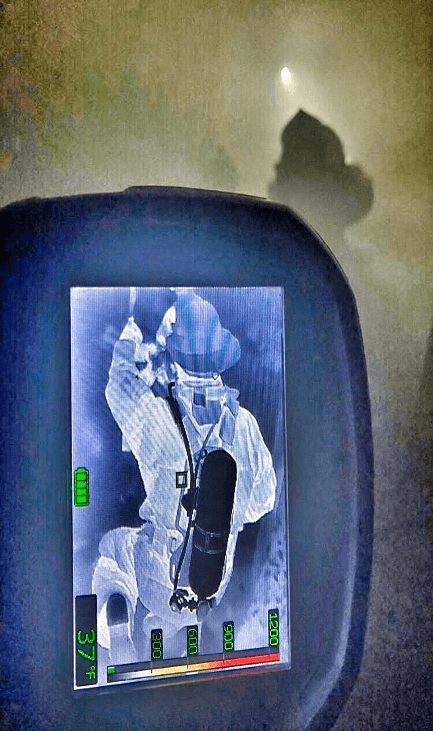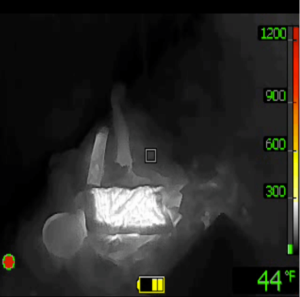The fire service has experienced a significant increase in fire prevention codes the response of operations personnel to fires has significantly decreased. With the overall reduction in fires, this has the often reduces the ability of firefighters to gain on the job experience. Many Fire Departments are having to think of more creative ways to create realistic conditions for firefighters to train in that has a minimum impact on a departments budget. To combat local, state, and federal regulations, departments have turned to smoke generators and various types of smoke simulants. For the sake of this training bulletin, we will concentrate on water-based smoke simulants (cold smoke generators) and the effects of using these types of simulants for training purposes.
Smoke generators and smoke simulants (cold smoke) are the basic means for creating an environment that mimics conditions that firefighters may encounter during fire conditions but in a safe and controlled environment. While using this equipment, new firefighters can gain a safe introduction to low-visibility operations while seasoned firefighters’ hone their skills in advanced drills such as rapid intervention and thermal imagining. If a firefighter panics or experiences an emergency, smoke simulants (cold smoke) will allow firefighters to remove their mask during a learning opportunity rather than a true emergency.
However, Smoke simulants (or cold smoke) can also provide firefighters with an inaccurate learning experience when training with thermal imaging cameras. A majority of common smoke generators work with water-based smoke simulants, with the primary ingredient being water mixed with a few different active ingredients.
Tactical Considerations: These smoke simulants (cold smoke) environments can render thermal imaging cameras ineffective due to the following factors:
TIC’s work off the principle of emissivity. Any object that is viewed is compared to a perfect black body with an emissivity of 1. Fire Service TIC’s are set at .95 to .97 emissivity which is the common emissivity of everyday combustibles (carbonaceous materials-human skin, soot, wood, and in general most rough services). Any object or area that is viewed that is closer to zero emissivity is considered a mirror. These objects reflect infrared energy and provide either false readings and do not allow infrared energy to pass through. These smoke simulants have a different emissivity than that of a fire environment. In fact, any water based solution is similar to steam which can partially block or absorb Infrared radiation. The TIC views water as a solid or an opaque object/surface. Whereas, when a firefighter uses a TIC in a smoke filled environment, LWIR or long wave infrared radiation passes through smoke and is detected by the TIC as shown in this photo provided by Max Fire Training

High Moisture Content: The smoke produced from water-based smoke simulants (cold smoke) will vary in density and the time the smoke will hang in the air. The most commonly used smoke simulants are usually a mixture of water, glycols, and/or glycerine. These simulants produce a cold gray bellowing smoke that resembles the consistency of smoke often encountered by firefighters during fire extinguishment but without a dynamic heat range. Without dynamic heat range (or significant temperature difference), firefighters will encounter a gray environment that is without contrast or heat signatures. This is in contrast to what firefighters will see in an actual fire and may confuse firefighters as they try to revert back to their learned behavior from training. As we can see in this photo from a cold smoke training evolution, the victim was heated to 98.6 Degrees Fahrenheit which in itself isn’t inaccurate. The error in training firefighters this way is to train them to recognize a white hot victim whereas a victim in a superheated environment will be the colder. This will cause the victim to produce as dark which can be easily missed if firefighters scan to fast or don’t search appropriately. This is the hazard of uniform temperature environments when using a thermal imaging camera. The TIC will become blind in these zero contrast environments unless firefighters are properly trained on how to overcome these limitations.

So why do water-based smoke simulants (cold smoke) block our ability to see with thermal imaging cameras?
There are several reasons why cold smoke and moisture laden environments block a firefighters ability to see with the TIC. First, a fire service TIC has an optic system that consists of a germanium lens (found at the front of the TIC). Germanium is a thin metal that has high transmissivity properties that allows Infrared energy to pass through it, so the detector can then translate the IR signal into an image that we as firefighters later interpret. The issue occurs in any environment, whether heavy smoke or heavy moisture, when the particulate or moisture builds up on the germanium lens. This blocks the TIC’s ability to “see”.
Firefighters must be aware, that each time they wipe their facepiece that they should also wipe the lens of the thermal imaging camera to prevent moisture from blocking the optic lens. As the amount of moisture or smoke increases, so should the frequency of the number of times the lens must be wiped. This problem can also be lessened by staying low in environments that have a cooler air track in the lower areas of the room.
There have been numerous incidents where Fire Service thermal imaging cameras have “whited out” after firefighters have entered a structure where sprinklers have been activated and cold smoke has filled the space. In majority of the cases, firefighters have failed to wipe the thermal imaging cameras lens even though they have had to wipe their facepiece several times. It is of upmost importance that we understand thermal imaging cameras do not see through anything but detects long wave infrared radiation (LWIR) that is between 7-14 microns. The result is that the thermal imaging camera cannot see through the moisture and produces a white image as it is reading the moisture in the smoke simulant (cold smoke) and not the infrared energy that should be reaching the detector.
Potential Health Hazards with Cold Smoke?
For years, firefighter and fire service instructors have been under the impression that smoke simulants are not hazardous.
However, like other smoke simulants (cold smoke), there is always the possibility that there may be health risk. There have been several incidents where fire service instructors have suffered respiratory symptoms within 30 minutes of being exposed to oil-based smoke simulants (cold
smoke). These symptoms included coughing, shortness of breath, difficulty breathing, and chest tightness. One instructor was hospitalized for a week with chemical pneumonitis/lipoid pneumonia. **
As a remedy to this potential health risk, fire training facilities and organizations have turned to water-based smoke simulants (such as Froggy’s Fog). These smoke simulants consist of a water-based smoke fluid vapor and aerosols. In fact, this smoke simulant is simply water vapor and tiny droplets of various glycols. During training exercises, there has been documented testing where poorly maintained generators have emitted condensation that produced unwanted residues that may have been inhaled by firefighters and instructors. However, if generators are maintained and designed to work with the specific smoke simulant (cold smoke), evaporation will occur, and the smoke simulant will not produce residues.
Training Bulletin Summary:
Based on this research, it is recommended that firefighters and fire service instructors take the following actions when training with smoke simulants (cold smoke) to reduce any possible side effects due to exposure.
- Structures/training facilities should be ventilated to reduce exposures by removing the smoke simulate (cold smoke) immediately following a training exercise and prior to allowing instructors and firefighters to re-enter the structure/training facility.
- Instructors and firefighters should not be allowed to enter the structure/training facility without appropriate respiratory protection until smoke simulant (cold smoke) has been visibly cleared.
- Personnel should wear the appropriate PPE when refilling smoke generators reservoirs with oil-based or glycol-based smoke simulants.
- Personnel should wash hands after each training rotation and shower at the end of the training exercise to remove all chemicals from the skin.
- Firefighters should NOT remove their SCBA in these environments especially those prone to respiratory distress (asthma, etc.).
Firefighting by its nature is a demanding and strenuous profession. Each day, in the field and while training, firefighters are exposed to unavoidable dangers. It’s with the utmost importance that instructors and firefighters take the necessary precautions to avoid these hazards. While training with smoke stimulants is still considered by many to be nonhazardous, we have found that they have posed health risk. Train hard and smart.
What if Live Fire Training is not an option?
We recommend using smoke simulators only when live fire training is not an option but to include the following:
- Ensure the smoke simulant is non-flammable and water based.
- Ensure that all instructors who will be supervising or assisting students wear full PPE or PPE with a respirator.
- Use heat sources to produce heat patterns to simulate fire and thermal bridging. This can be achieved by using a space heater behind a closed door.
- Do not preheat mannequins or use live victims as they will appear white hot through the TIC. Use mannequins or rescue dummies that are cold. This can be achieved by placing them in an air conditioned room overnight or small mannequins can be kept in a cooler. As the day progresses, do not remove the mannequins and replace them with colder ones. Show the same group that conducted the search initially how the victim stood out due to their cold/contrasting temperature with the environment as a 98.6 degree victim will appear dark in a superheated environment. However, once the victim is deceased, their body is no longer regulating temperature and becomes a passive emitter. Therefore, overtime the victim’s body will blend in with the objects around them as they will become the same temperature. This provides a more realistic skill set for the firefighter to identify victims based on overall background temperatures and body temperatures.
